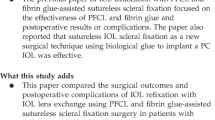Background: Having changed our cataract operation technique from ECCE to phaco-emulsification (PE) we had the impression of less fibrinous membranes postoperatively.
Method: To ascertain whether our impression was correct, we examined the last 2056 IOL implanted cataract patients retrospectively.
Results: In the 2056 cataract cases we found 152 fibrinous reactions (7.4%). We observed after ECCE (n=586) a 12.8% rate of fibrinous membranes, after phacoemulsification (PE) with sutured 6.5-mm corneoscleral incision (n=546) 7.0%, and after PE with clear corneal self-sealing 4.1-mm incision (n=924) only 3.9%. In 56% of these patients we found diabetes, in 13% former uveitis with posterior synechiae, in 11% glaucoma with rigid pupil, and in 10% pseudoexfoliation syndrome. In those cases with no diabetic retinopathy but known diabetes (n=198), we found a 27% rate of fibrin reactions following ECCE (12 mm), 12% following PE (6.5 mm) and 8% following PE (4.1 mm). In non-proliferative diabetic retinopathy (n=80) a 32% rate of fibrinous changes was observed after ECCE, 18% after PE (6.5 mm), and 9% after PE (4.1 mm). In cases of uncomplicated ECCE (n=341) the rate of fibrinous reactions amounted to 22.4% following prolonged procedures (>50 min) by residents, while it was as low as 9,5% following operations of short duration (<30 min) by experienced surgeons. Intraocular injection of tPA (25 µg) was the most effective treatment.
Conclusion: The self-sealing corneal small incision cataract technique guarantees a short duration of the surgical procedure and the last fibrinous reactions.
Nach Einführung der kornealen nahtfreien Operationstechnik entstand der Eindruck, daß wesentlich seltener Fibrinreaktionen nach IOL-Implantation auftraten.
Methode: Zur statistischen Überprüfung wurden die letzten 2056 Kataraktoperationen mit Linsenimplantation retrospektiv analysiert.
Ergebnisse: Unter 2056 Patienten nach Staroperation fanden sich insgesamt 152 (7,4%) Fibrinreaktionen, und zwar nach extrakapsulärer Operation mit vernähtem 12-mm-Korneoskleralschnitt (n=586) 12,8%, nach Phakoemulsifikation (PE) mit vernähtem 6,5-mm-Korneoskleralschnitt (n=546) 7,0% und nach Phakoemulsifikation mit unvernähtem 4,1-mm-Kornealschnitt nur 3,9%. 56% der Patienten mit Fibrinreaktion wiesen einen Diabetes mellitus, 13% hintere Synechien nach Uveitis, 11% ein Glaukom und 10% ein Pseudoexfoliationssyndrom auf. Bei Diabetes ohne Retinopathie (n=198) kam es in 27% nach extrakapsulärer Operation (12 mm), in 12% nach PE mit (6,5 mm) und in 8% nach PE ohne vernähtem Schnitt (4,1 mm) zur Fibrinreaktion. Bei nicht proliferativer diabetischer Retinopathie (n=80) wurde in 32% nach extrakapsulärer Operation, in 17% nach PE mit (6,5 mm) und in 9% nach PE ohne vernähtem Schnitt (4,1 mm) eine postoperative Fibrinbildung beobachtet. Nach unkomplizierter extrakapsulärer Operation (n=341) betrug die Zahl der Fibrinreaktionen bei routinierten Mikrochirurgen (Operationsdauer <30 min) 9,5%, bei Facharztanwärtern (Operationsdauer >50 min) 22,4%. Die intraokulare Applikation von 25 µg tPA (Tissue-Plasminogen-Aktivator) stellte die effektivste Therapie dar.
Schlußfolgerung: Die nahtfreie korneale Kleinschnittchirurgie gewährleistet bei kurzer Operationszeit die wenigsten postoperativen Fibrinreaktionen.
Similar content being viewed by others
Author information
Authors and Affiliations
Rights and permissions
About this article
Cite this article
Müller-Jensen, K., Rörig, M., Hägele, J. et al. Einfluß von Katarakttechnik und Operationsdauer auf die Fibrinreaktion nach IOL-Implantation. Ophthalmologe 94, 38–40 (1997). https://doi.org/10.1007/s003470050081
Issue Date:
DOI: https://doi.org/10.1007/s003470050081




